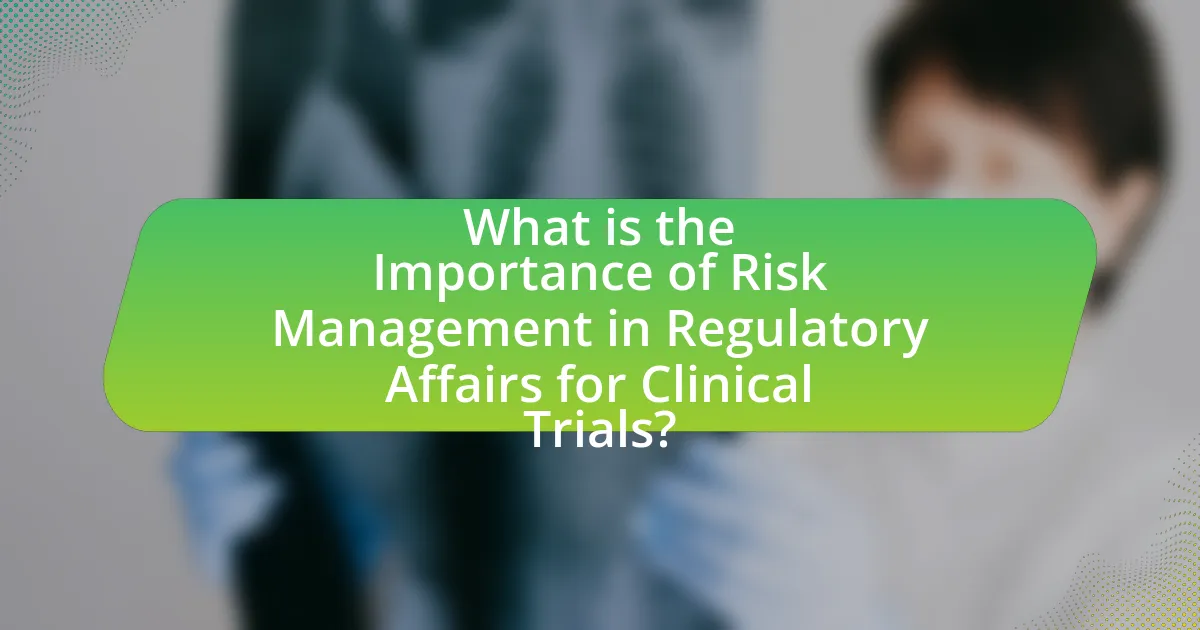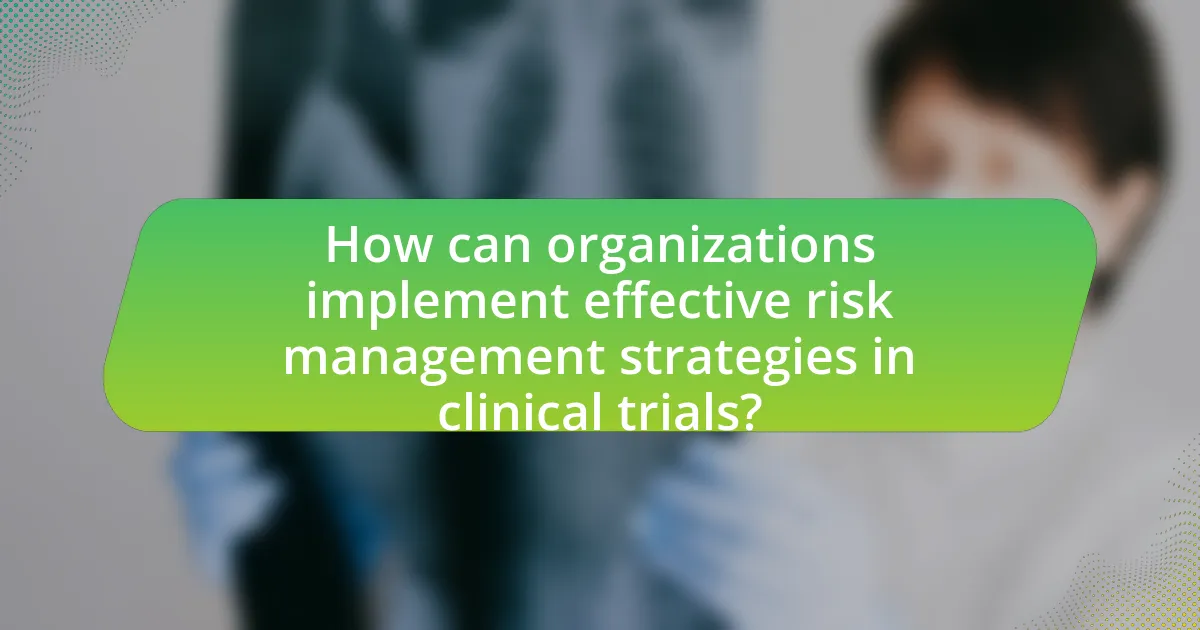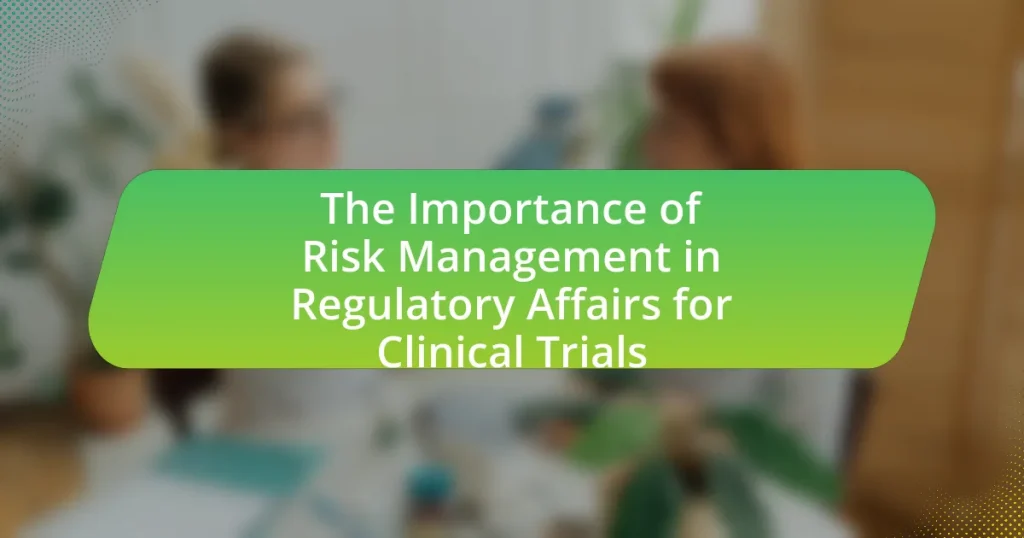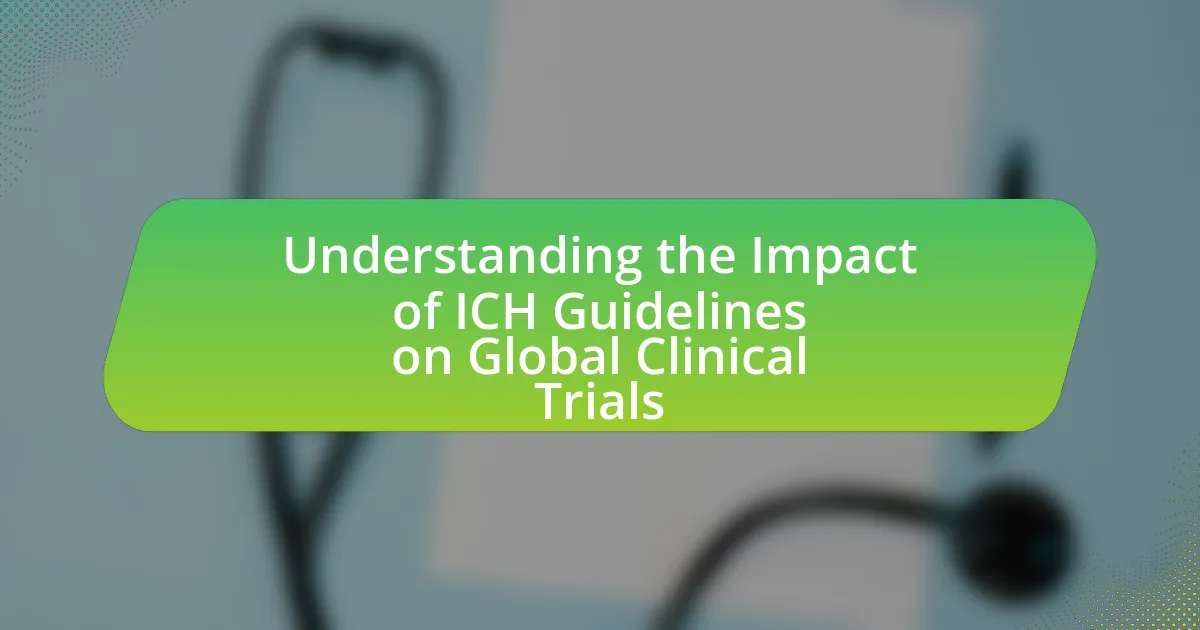Risk management is a critical component of regulatory affairs in clinical trials, ensuring patient safety, compliance with regulations, and the integrity of trial data. This article outlines the importance of effective risk management practices, including risk identification, assessment, control, communication, and continuous monitoring, as mandated by guidelines from the International Conference on Harmonisation (ICH) and other regulatory bodies. It discusses the potential risks associated with clinical trials, the impact of unforeseen risks on trial outcomes and regulatory approval, and the best practices organizations can adopt to enhance risk management strategies. Additionally, the article highlights the role of training and technology in fostering a culture of risk awareness and improving compliance with regulatory standards.

What is the Importance of Risk Management in Regulatory Affairs for Clinical Trials?
Risk management is crucial in regulatory affairs for clinical trials as it ensures patient safety, compliance with regulations, and the integrity of trial data. Effective risk management identifies potential hazards early, allowing for the implementation of mitigation strategies that protect participants and enhance the reliability of results. According to the International Conference on Harmonisation (ICH) guidelines, a structured approach to risk management is essential for maintaining compliance with regulatory requirements, thereby facilitating smoother trial approvals and reducing the likelihood of costly delays or rejections.
Why is risk management critical in the context of regulatory affairs?
Risk management is critical in the context of regulatory affairs because it ensures compliance with legal and ethical standards while safeguarding public health. Effective risk management identifies, assesses, and mitigates potential risks associated with clinical trials, thereby minimizing the likelihood of regulatory violations and adverse events. For instance, the International Conference on Harmonisation (ICH) guidelines emphasize the need for a risk-based approach to monitoring clinical trials, which has been shown to enhance patient safety and data integrity. By systematically addressing risks, organizations can avoid costly delays, fines, and reputational damage, ultimately leading to more successful regulatory submissions and approvals.
What are the key principles of risk management in clinical trials?
The key principles of risk management in clinical trials include risk identification, risk assessment, risk control, risk communication, and continuous monitoring. Risk identification involves recognizing potential risks that could impact trial outcomes, such as patient safety and data integrity. Risk assessment evaluates the likelihood and impact of these risks, allowing for prioritization. Risk control focuses on implementing strategies to mitigate identified risks, ensuring compliance with regulatory standards. Risk communication ensures that all stakeholders are informed about risks and management strategies. Continuous monitoring involves regularly reviewing risk management processes and outcomes to adapt to new challenges. These principles are essential for maintaining the integrity and safety of clinical trials, as supported by guidelines from regulatory bodies like the International Council for Harmonisation (ICH) and the Food and Drug Administration (FDA).
How does risk management influence regulatory compliance?
Risk management significantly influences regulatory compliance by identifying, assessing, and mitigating potential risks that could lead to non-compliance with regulations. Effective risk management practices ensure that organizations adhere to regulatory requirements by proactively addressing issues that may arise during clinical trials. For instance, the International Conference on Harmonisation (ICH) guidelines emphasize the importance of risk-based approaches in clinical trial management, which helps organizations maintain compliance with Good Clinical Practice (GCP) standards. By systematically evaluating risks, organizations can implement controls that align with regulatory expectations, thereby reducing the likelihood of violations and enhancing overall compliance.
What are the potential risks associated with clinical trials?
The potential risks associated with clinical trials include adverse effects on participants, data integrity issues, and ethical concerns. Adverse effects can range from mild reactions to severe complications, as evidenced by reports indicating that approximately 5% of participants experience serious adverse events during trials. Data integrity issues may arise from improper data collection or analysis, leading to unreliable results; for instance, a study published in the Journal of Clinical Oncology highlighted that flawed data management can compromise trial outcomes. Ethical concerns often involve informed consent and the potential for exploitation of vulnerable populations, underscoring the necessity for stringent ethical oversight in clinical research.
What types of risks can arise during clinical trial phases?
During clinical trial phases, various types of risks can arise, including safety risks, regulatory compliance risks, operational risks, and financial risks. Safety risks involve adverse effects on participants, which can lead to serious health issues or even fatalities, as evidenced by historical incidents like the TGN1412 trial in 2006, where participants experienced severe reactions. Regulatory compliance risks stem from failing to adhere to guidelines set by authorities such as the FDA or EMA, potentially resulting in trial delays or disqualification. Operational risks include issues related to trial design, recruitment challenges, and data management, which can compromise the integrity of the study. Financial risks arise from unexpected costs or funding shortfalls, impacting the trial’s viability. Each of these risks necessitates robust risk management strategies to ensure the successful conduct of clinical trials.
How can unforeseen risks impact trial outcomes and regulatory approval?
Unforeseen risks can significantly compromise trial outcomes and hinder regulatory approval by introducing unexpected variables that affect data integrity and participant safety. For instance, if a trial encounters unanticipated adverse events, it may lead to increased dropout rates, skewed results, or even trial suspension, which can delay the submission of data to regulatory bodies. Historical examples, such as the Vioxx case, illustrate how unforeseen risks can lead to withdrawal of a drug from the market after approval due to safety concerns, emphasizing the critical need for robust risk management strategies throughout the clinical trial process.
How does effective risk management enhance clinical trial success?
Effective risk management enhances clinical trial success by identifying, assessing, and mitigating potential risks that could jeopardize trial outcomes. By proactively addressing issues such as patient safety, regulatory compliance, and data integrity, risk management ensures that trials are conducted efficiently and ethically. For instance, a study published in the Journal of Clinical Research found that implementing a structured risk management framework reduced trial delays by 30% and improved patient recruitment rates by 25%. This demonstrates that effective risk management not only safeguards participants but also streamlines processes, ultimately leading to more successful clinical trials.
What role does risk assessment play in trial design?
Risk assessment plays a critical role in trial design by identifying, evaluating, and mitigating potential risks that could impact the safety and efficacy of the clinical trial. This process ensures that the trial is designed to minimize adverse effects on participants while maximizing the reliability of the results. For instance, regulatory guidelines such as those from the International Council for Harmonisation (ICH) emphasize the necessity of risk-based approaches in clinical trial planning, which helps in prioritizing resources and focusing on the most significant risks. By systematically addressing these risks, trial designers can enhance participant safety and improve the overall quality of the data collected, ultimately leading to more robust regulatory submissions.
How can proactive risk management strategies improve patient safety?
Proactive risk management strategies improve patient safety by identifying and mitigating potential hazards before they result in harm. These strategies involve systematic processes such as risk assessment, monitoring, and implementing preventive measures, which can significantly reduce the likelihood of adverse events during clinical trials. For instance, a study published in the Journal of Clinical Research found that proactive risk management led to a 30% decrease in serious adverse events in clinical trials by addressing risks early in the study design phase. This approach not only enhances patient safety but also fosters a culture of safety within clinical research environments.

What are the regulatory frameworks governing risk management in clinical trials?
The regulatory frameworks governing risk management in clinical trials primarily include the International Council for Harmonisation (ICH) guidelines, particularly ICH E6(R2), which outlines Good Clinical Practice (GCP) standards. These guidelines emphasize the need for a systematic approach to risk management, ensuring that risks to trial participants are minimized and that data integrity is maintained. Additionally, the U.S. Food and Drug Administration (FDA) and the European Medicines Agency (EMA) provide specific regulations and guidance documents that further define risk management processes, such as the FDA’s Guidance for Industry on Risk Evaluation and Mitigation Strategies (REMS) and the EMA’s guidelines on the management of clinical trial risks. These frameworks collectively establish a comprehensive structure for identifying, assessing, and mitigating risks throughout the clinical trial process, ensuring compliance with ethical and scientific standards.
Which regulatory bodies oversee risk management practices?
The regulatory bodies that oversee risk management practices include the Food and Drug Administration (FDA) in the United States, the European Medicines Agency (EMA) in the European Union, and the International Conference on Harmonisation (ICH). These organizations establish guidelines and regulations that ensure the safety and efficacy of clinical trials, thereby enforcing risk management protocols. For instance, the FDA’s guidance on risk management emphasizes the need for a systematic approach to identify, assess, and mitigate risks associated with clinical research, while the EMA provides a framework for risk assessment in the context of medicinal products. The ICH also contributes by harmonizing regulatory requirements across different regions, facilitating a consistent approach to risk management in clinical trials globally.
What guidelines do these regulatory bodies provide for risk management?
Regulatory bodies provide comprehensive guidelines for risk management in clinical trials, emphasizing the identification, assessment, and mitigation of risks to ensure participant safety and data integrity. For instance, the International Council for Harmonisation (ICH) E6(R2) guidelines outline the need for a risk-based approach to monitoring, which includes defining critical study parameters and implementing appropriate oversight measures. Additionally, the U.S. Food and Drug Administration (FDA) encourages sponsors to develop a risk management plan that identifies potential risks and outlines strategies for their mitigation, as detailed in the FDA’s Guidance for Industry on Risk Management. These guidelines are essential for maintaining compliance and enhancing the overall quality of clinical trials.
How do international regulations differ in their approach to risk management?
International regulations differ in their approach to risk management primarily through their frameworks, methodologies, and specific requirements. For instance, the European Union’s Clinical Trials Regulation emphasizes a risk-based approach that requires sponsors to assess and mitigate risks throughout the trial process, aligning with the principles outlined in the International Council for Harmonisation’s Good Clinical Practice guidelines. In contrast, the U.S. Food and Drug Administration focuses on a more flexible, sponsor-driven risk management strategy, allowing for greater discretion in how risks are identified and managed, as seen in their guidance documents. These differences reflect varying regulatory philosophies, with the EU prioritizing comprehensive risk assessment and the U.S. promoting innovation and efficiency in clinical trial management.
What are the consequences of inadequate risk management in clinical trials?
Inadequate risk management in clinical trials can lead to significant consequences, including compromised patient safety, regulatory non-compliance, and financial losses. Compromised patient safety may result from unaddressed risks, leading to adverse events that can harm participants and undermine the integrity of the trial. Regulatory non-compliance occurs when trials fail to meet established guidelines, potentially resulting in penalties, trial suspension, or disqualification of data. Financial losses can arise from increased costs associated with managing crises, delays in trial timelines, and the potential need for additional studies to address unforeseen issues. These consequences highlight the critical need for effective risk management strategies in clinical trials to ensure safety, compliance, and financial viability.
How can poor risk management lead to regulatory penalties?
Poor risk management can lead to regulatory penalties by failing to identify, assess, and mitigate risks associated with clinical trials, which can result in non-compliance with regulatory standards. Regulatory bodies, such as the FDA and EMA, impose penalties when organizations do not adhere to guidelines that ensure participant safety and data integrity. For instance, a study by the FDA indicated that inadequate risk management practices contributed to 30% of the violations reported during clinical trials, leading to fines and sanctions. This demonstrates that poor risk management directly correlates with increased regulatory scrutiny and potential financial repercussions.
What impact does inadequate risk management have on public trust in clinical research?
Inadequate risk management significantly undermines public trust in clinical research. When risks are not properly identified, assessed, and mitigated, it can lead to adverse events, ethical violations, and data integrity issues, which erode confidence among participants and the general public. For instance, a study published in the Journal of Medical Ethics found that transparency in risk management practices correlates with higher levels of public trust, indicating that perceived negligence can lead to skepticism about the safety and efficacy of clinical trials. This skepticism can result in lower participation rates, hindering the advancement of medical research and public health initiatives.

How can organizations implement effective risk management strategies in clinical trials?
Organizations can implement effective risk management strategies in clinical trials by establishing a comprehensive risk assessment framework that identifies, evaluates, and mitigates potential risks throughout the trial process. This framework should include systematic risk identification methods, such as brainstorming sessions and historical data analysis, to pinpoint risks related to patient safety, data integrity, and regulatory compliance.
Furthermore, organizations should prioritize continuous monitoring and reporting mechanisms to track identified risks and their mitigation strategies, ensuring timely adjustments as necessary. For instance, the use of risk-based monitoring approaches, as recommended by the FDA, allows for focused oversight on high-risk areas, enhancing overall trial integrity.
Additionally, training staff on risk management principles and fostering a culture of transparency and communication can significantly improve the effectiveness of these strategies. Research indicates that organizations employing structured risk management practices can reduce trial delays and improve compliance with regulatory standards, ultimately leading to more successful trial outcomes.
What best practices should organizations follow for risk management?
Organizations should follow best practices for risk management by implementing a structured risk assessment process, establishing a risk management framework, and fostering a culture of risk awareness. A structured risk assessment process involves identifying, analyzing, and prioritizing risks based on their potential impact on clinical trials, ensuring that organizations can allocate resources effectively. Establishing a risk management framework, such as the ISO 31000 standard, provides guidelines for integrating risk management into organizational processes, enhancing decision-making and compliance with regulatory requirements. Fostering a culture of risk awareness encourages all employees to recognize and report risks, which is crucial for maintaining safety and efficacy in clinical trials. These practices are supported by the fact that organizations with robust risk management strategies are more likely to meet regulatory standards and achieve successful trial outcomes.
How can organizations foster a culture of risk awareness among staff?
Organizations can foster a culture of risk awareness among staff by implementing comprehensive training programs that emphasize the identification, assessment, and management of risks. These programs should include real-life case studies and simulations relevant to clinical trials, which help staff understand the implications of risk management in regulatory affairs. Research indicates that organizations with structured risk management training see a 30% increase in staff engagement regarding risk awareness, as reported by the Risk Management Society. Additionally, promoting open communication channels where employees can report potential risks without fear of repercussions further enhances this culture. Regular workshops and discussions led by risk management experts can also reinforce the importance of proactive risk identification and mitigation strategies.
What tools and technologies can assist in risk management for clinical trials?
Tools and technologies that assist in risk management for clinical trials include electronic data capture (EDC) systems, risk-based monitoring (RBM) software, and statistical analysis tools. EDC systems streamline data collection and enhance data integrity, allowing for real-time monitoring of trial progress and participant safety. RBM software enables sponsors to focus resources on higher-risk sites and patients, improving oversight and reducing costs. Statistical analysis tools facilitate the identification of potential risks through data analysis, enabling proactive decision-making. These technologies collectively enhance the efficiency and effectiveness of risk management strategies in clinical trials.
What are the common challenges faced in risk management for clinical trials?
Common challenges faced in risk management for clinical trials include identifying potential risks, ensuring compliance with regulatory requirements, and managing data integrity. Identifying potential risks is complicated by the complexity of trial designs and the variability in patient populations, which can lead to unforeseen adverse events. Compliance with regulatory requirements is challenging due to the evolving nature of regulations and the need for continuous monitoring to ensure adherence. Additionally, maintaining data integrity is critical, as inaccuracies can compromise trial results and lead to regulatory scrutiny. These challenges necessitate robust risk management strategies to mitigate potential issues effectively.
How can organizations overcome barriers to effective risk management?
Organizations can overcome barriers to effective risk management by implementing a structured risk management framework that includes regular training, clear communication, and stakeholder engagement. A structured framework ensures that all team members understand their roles in identifying and mitigating risks, which is crucial in the context of regulatory affairs for clinical trials. Regular training sessions enhance the team’s ability to recognize potential risks early, while clear communication fosters a culture of transparency and accountability. Engaging stakeholders, including regulatory bodies and clinical trial participants, allows organizations to gather diverse perspectives and insights, further strengthening their risk management strategies. Studies show that organizations with robust risk management practices are more likely to comply with regulatory requirements and achieve successful trial outcomes.
What role does training play in addressing these challenges?
Training plays a crucial role in addressing challenges in risk management within regulatory affairs for clinical trials. It equips professionals with the necessary knowledge and skills to identify, assess, and mitigate risks effectively. For instance, training programs that focus on regulatory compliance and risk assessment methodologies enhance the ability of clinical trial teams to navigate complex regulatory environments, thereby reducing the likelihood of non-compliance and associated penalties. Research indicates that organizations with comprehensive training initiatives experience a 30% reduction in compliance-related issues, demonstrating the effectiveness of training in fostering a culture of risk awareness and proactive management.
What practical steps can organizations take to enhance risk management in clinical trials?
Organizations can enhance risk management in clinical trials by implementing a comprehensive risk assessment framework. This framework should include identifying potential risks early in the trial process, utilizing tools such as risk matrices to prioritize these risks based on their likelihood and impact. Additionally, organizations should establish continuous monitoring systems to track risk indicators throughout the trial, allowing for timely interventions. Training staff on risk management protocols and fostering a culture of transparency and communication regarding risks can further strengthen the approach. Evidence from the FDA emphasizes that proactive risk management can lead to improved trial outcomes and regulatory compliance, highlighting the necessity of these steps in clinical research.
How can regular risk assessments improve trial outcomes?
Regular risk assessments can significantly improve trial outcomes by identifying potential issues early, allowing for timely interventions. By systematically evaluating risks throughout the trial process, researchers can mitigate factors that may lead to delays, increased costs, or compromised data integrity. For instance, a study published in the Journal of Clinical Research found that trials employing regular risk assessments experienced a 30% reduction in protocol deviations, which directly correlates with improved data quality and reliability. This proactive approach not only enhances participant safety but also increases the likelihood of meeting regulatory requirements, ultimately leading to more successful trial completions.
What strategies can be employed to continuously monitor and mitigate risks?
Continuous monitoring and mitigation of risks in clinical trials can be achieved through several key strategies. Implementing a robust risk management framework allows for the identification, assessment, and prioritization of risks throughout the trial lifecycle. Regularly scheduled risk assessments, utilizing tools such as risk registers, enable teams to track potential issues and their impact on trial outcomes. Additionally, employing real-time data analytics facilitates the early detection of deviations from expected results, allowing for timely interventions.
Furthermore, establishing clear communication channels among stakeholders ensures that all parties are informed of emerging risks and can collaborate on mitigation strategies. Training staff on risk awareness and response protocols enhances the overall risk management culture within the organization. According to the FDA’s guidance on risk management in clinical trials, these proactive measures are essential for maintaining compliance and ensuring participant safety, ultimately leading to more successful trial outcomes.






